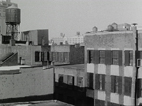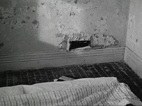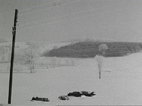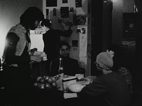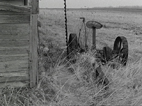One Year
- Robert Huot |
- 1970 |
- 38 minutes |
- B&W |
- SILENT
Rental Format(s): 16mm film / Digital File
Sale Format(s): DVD
An excerpt from THE FILMS OF ROBERT HUOT: 1967 to 1972 by Scott MacDonald
During the 1970s Huot has continued to make short films. The majority of his filmmaking energy, however, has been channeled into a series of diaries - five have been completed as of this writing - which give evidence of his growing commitment to film and of his considerable creative abilities in the new medium. One Year (1970) was clearly a turning point. While the short early works were interesting films by a painter, One Year (1970) reveals Huot's sustained attempt to make filmmaking a constant element, if not the central element, of his creative life. One Year (1970) is a series of forty-nine rolls of 16mm film, nearly all of them unedited except in the camera, and all of them silent. The flares at the beginnings and ends of the rolls are not eliminated and, as a result, become a form of visual punctuation. The rolls are arranged so that, as title implies, we move gradually through an entire year, from winter to winter. The most interesting aspect of the overall organization, however, involves the fact that the first quarter of One Year (1970) is very different from the final three-quarters: this change reflects a fundamental alteration in Huot's approach to film.
The most obvious quality of the first part of One Year (1970) is the care and intensity with which Huot chooses and records his imagery. Of the first nine rolls, eight are gems; had they been released individually in 1970, they would have established Huot as an interesting young filmmaker with concerns and abilities related to those of Larry Gottheim and Barry Gerson. In several instances these early rolls are interesting because of the simple beauty or power or humor of Huot's imagery. The second roll, for example, records a series of spectacular smokescapes created by a street-level steam vent in lower Manhattan. The fast-swirling smoke in dark, rather ghostly streets creates a mood reminiscent of the German Expressionists. The fourth roll presents six approximately thirty-second shots of the wake of a ship, framed so as to capture the three-dimensional, multidirectional movements of the water within two-dimensional compositions of powerfully conflicting forces. Each shot crates a different composition in which different kinds of forces become evident. Sometimes the collision of different portions of the wake is emphasized; sometimes one is aware of the conflict between the glittering surface of the water and the immense forces welling up underneath. Always, however, one is aware that the powerful imagery one is seeing is a result of Huot's ability to frame an aspect of everyday reality in such a way as to discover its filmic potential. In the eighth roll Huot captures several black cows in a white winterscape, standing in humorous positions, often miraculously moving in unison as though they've been choreographed.
Other rolls in the first section of the film show aspects of film process and equipment. Perhaps the most impressive roll in all of One Year (1970) is the third, in which Huot presents a city intersection filmed from above at consecutively slower speeds. The intersection itself is quite complex; cars and trucks move up and down various one-way streets, people walk along the sidewalks and across the streets, a yellow light on a utility truck a block away whirls around and around, and a window on the second story of a building reflects events occurring outside the film frame. Sometimes events in the foreground capture one's attention: at other times one tries to decipher events several blocks away. As the intersection is presented at slower speeds, people and vehicles seem to drift through the scene, and the multiplicity of events grows increasingly easy to examine.
At the same time, the texture of the image becomes grainier, the focus softer, the implicit perspective flatter. The result is that while the imagery becomes less difficult to explore in one sense, it grows more ambiguous in another. All in all, the roll is beautiful in its clear demonstration of some of the formal effects of peculiarly filmic elements on filmed imagery.
I can#t resist a brief mention of two other early rolls - the fifth and the ninth - in which Huot continues to explore the interest in minimalism which dominated his earliest films. The fifth presents a single cow enclosed, apparently, by a corral made of posts and wire. After a few moments, the cow suddenly disappears - we realize that Huot has simply stopped shooting, waited for the cow to walk out of the corral and the image, and he continued to shoot - then the viewer is left to mediate for the remainder of the roll on the power and limitations of the film frame, which, like the corral, tends to direct our attention while remaining entirely ineffective in any physical sense. In the ninth roll Huot films a tiny rivulet of cold, clear water trickling over little rapids through a serene winter landscape. His otherwise continuous shooting is regularly interrupted every thirty seconds or so by a tiny flash of light which indicated that the camera has stopped and stared, though no visible change in the imagery occurs as a result. This little roll is effective both as a serialist meditation on a moment and place of natural beauty (the intermission flashes are subtle attention receivers which regularly reconfirm the value of looking at the simple lovely scene) and as a metaphor for the editing process: the flow of the filmed image of the stream is regularly interrupted by Huot#s rudimentary editing, just as the flow of the stream itself is interrupted by the tiny rapids.
By the end of the first dozen rolls of One Year (1970), Huot has demonstrated to the attentive viewer - as he apparently needed to demonstrate to himself - that he was perfectly capable of creating interesting and beautiful films by combining intensity of perception, sensitivity to composition, and judicious use of film technique. During the remaining three-quarters of the film, however, he turns his back on the accomplishments of the early rolls; by dint of will he seems to leave his artistic propensities behind and becomes an amateur.
According to Huot, the reasons for this change dates back to the late 1960s and the conflux of political, economic, social, and aesthetic concerns which led finally to his decision to disassociate himself from the New York City art world and the elitist assumptions about the making and understanding of art which, in his view, were dominating it. Art, he had come to feel, needed to do more than examine its own materials and processes in forms which were accessible only to an in-group of art critics and other artists. In January, 1970, he moved to a small farm in upstate New York and became increasingly committed to creating films and paintings which would more adequately reflect his broadening concerns and which might have a wider appeal. Of course, the differences between the early short films and the first dozen rolls of One Year (1970) are to a degree reflective of his change, but after the first reel (in its present form the film is distributed on four reels with twelve, twelve, thirteen, and twelve rolls, respectively), the change is more radical. The last three reels of One Year (1970) are in large measure a record in Huot's involvement in renovating the farm, keeping the land productive, and just generally exploring his new terrain. There are rolls of men laying a cement foundation, of a hay field being limed, of people striping and polishing floors, and of the weather, the flora, and the fauna of the farm. Instead of photographing this subject matter with the sophisticated aesthetic detachment which characterizes the early rolls, Huot took the camera off the tripod and filmed as
informally as he could, not worrying about the nuances of exposure and composition. Not surprisingly, many of these rolls are relatively uninteresting for a general audience, but Huot#s decision to relax and let things happen filmically had both the long-term benefits as well: a viewer who remains alert during the final three reels of One Year (1970) can discover interesting visual experiences, some a few seconds long, others lasting entire rolls.
Several of the later rolls deserve special mention. In more than one instance Huot#s new informality with the camera led him to play a kind of visual game, which is recreated when the viewer sees the film. On the tenth roll of the second reel Huot#s camera follows birds that are flying into and out of a field of weeds. Usually the birds fly singly and since Huot is shooting in long shot, they appear as tiny black dots on a grey landscape. What strikes me as fascinating is the speed with which viewers actively involve themselves in the game. After the camera has followed two or three birds, viewers tend to eliminate all other aspects of the image from their consciousness. In those instances when a bird is not clearly visible, one tends to scan the image with some anxiety so that no portion of the game is missed. Other interesting rolls result from Huot's ability to recognize the potential of accidents and mistakes. The sixth roll of reel 4 presents the meeting of a baby goat and a pet dog. Huot does his best to simply record the funny interaction of the two friendly but nervous animals; the dog tries to play; the goat, much to the dog's apparent shock, continually tries to mount. At the end of the roll they resolve their meeting, effecting small miracle of composition: the dog walks to the far left of the image, comes forward, and looks directly into the camera as the film flares out and the roll ends. Throughout almost the entirety of the eleventh roll of reel 2, the viewer sees nothing but the dance of black and white film grain and extremely faint modulations which hint at shadowy shapes. Concentration on the grain tends to create optical illusions - color afterimages, etc. - reminiscent of those developed by Tony Conrad in the Flicker and Taka limura in Shutter. Only at the end of the roll, when we see two tiny dots of light in the upper center of the image, do we suspect that the optical experiences were accidentally produced as a result of Huot's underexposure of some nighttime imagery and that the ghostly images that sometimes seem to inhabit the grain are not optical illusions, but barest imprint of photographic imagery.
By 1971 Huot was in a peculiar situation. He had demonstrated his ability to create effective films by bringing his interests in artistic formalism and minimalism to bear on a new medium, but he had stepped away from that kind of filmmaking, apparently for ideological reasons. And he had proved that he could become completely at ease with the camera as an informal recording device. What is most apparent as one watches One Year (1970) in it entirety, though, is that if many of the rewards of the first reel, like the rewards of the early short films, are available to a relatively small group of rather savvy film lovers, the simple length of the last three reels - the amount of informal personal recording one must go through in order to discover the sudden surprising rewards - limits the appeal of the film even more fully. According to Huot, the length of One Year (1970) is a result of a prior decision to accept the footage he created, rather than to cull from it only that material which looks "artistic," or "beautiful," or "professional." The idea of having a "shooting ratio," the assumption that filmmakers will waste much of the footage they record, seemed to Huot a filmic reflection of a conspicuously-consuming society which had little respect for its natural or human resources. He was determined to make films which would offer an alternative. The decision to string rolls of film together chronologically in One Year (1970) was a less-than-effective result of this thinking, but during the months following the completion of the first diary, Huot discovered a way of using all the footage he shot, while avoiding the pitfalls of the first diary's organization. Using editing as a means of taking a dialectic step forward, Huot created Rolls: 1971 and Third One-Year Movie-1972, his two finest films to date.
The entire text can be seen at http://www.roberthuot.com/surprise/


